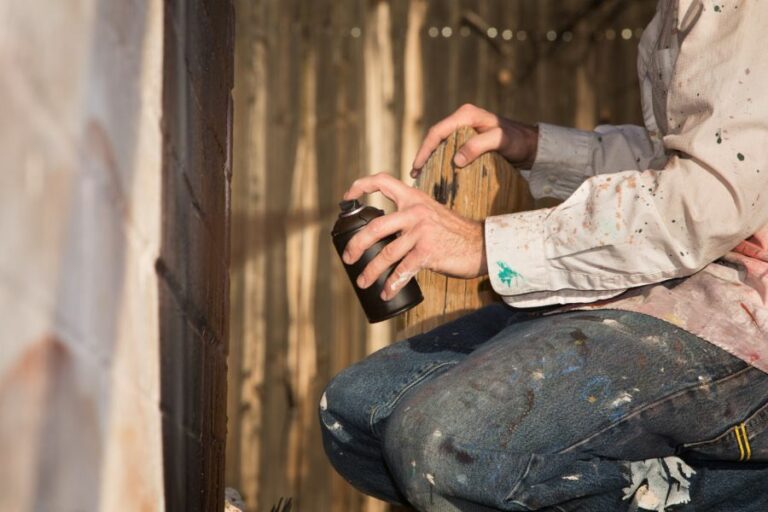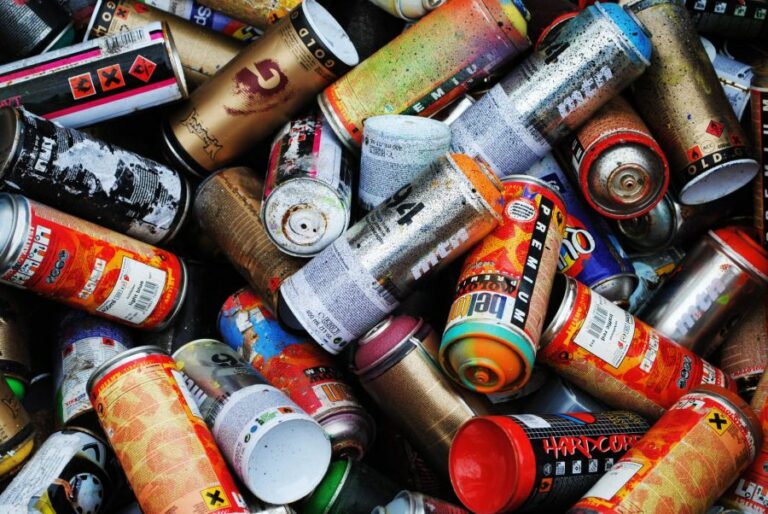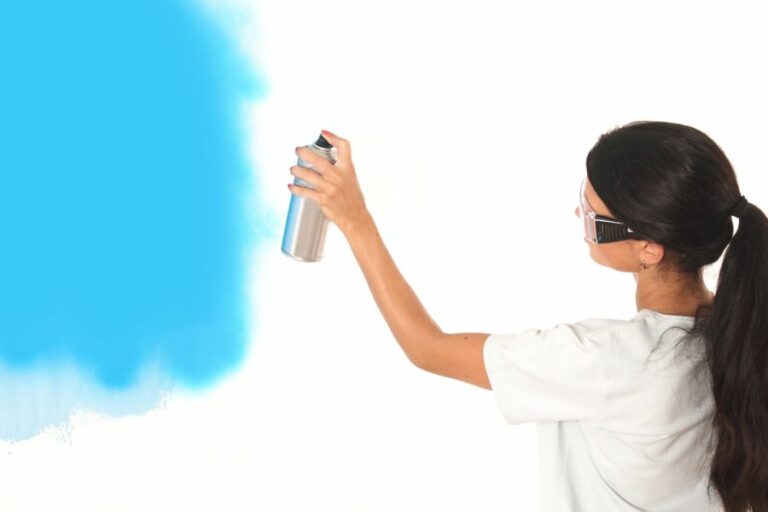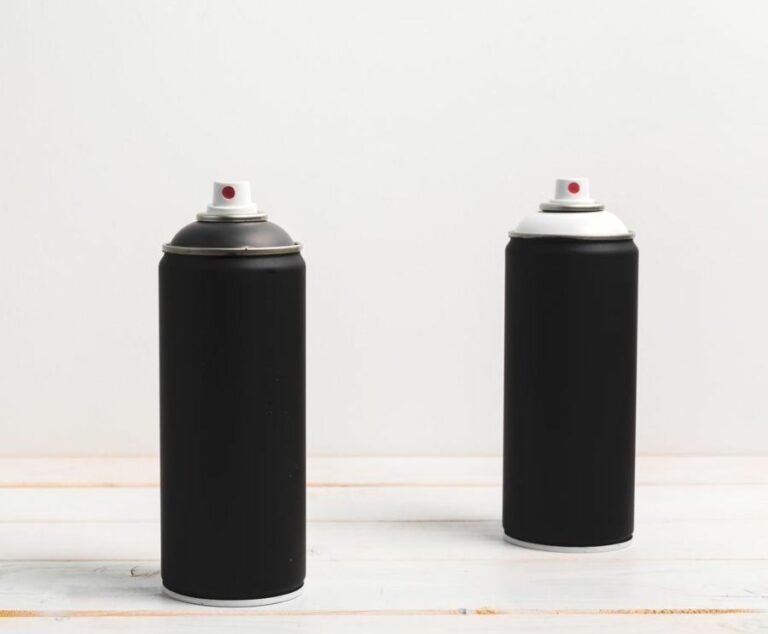Quick Spray Paint Removal Indoors & Outdoors. What Pros Say
Are you struggling with unsightly spray paint on your indoor or outdoor surfaces? Worry no more; we have the perfect solutions to get rid of it quickly and efficiently. From various techniques to handy products, we will guide you in tackling any spray paint mishap like a pro.
Quick spray paint removal indoors & outdoors:
To quickly remove spray paint indoors and outdoors, try baking soda and water paste on metal, glass, or concrete surfaces. Alternatively, use paint thinner or solvents on wood or plastic surfaces. For outdoor brick, concrete, or stonework, pressure washing is effective. Sanding may be necessary for stubborn paint or delicate surfaces. Prioritize safety and follow proper disposal procedures.

Are you struggling with unwanted spray paint on your indoor or outdoor surfaces? Don’t worry! We have tried and tested solutions to help you remove it quickly and effectively.
Read on to discover our step-by-step guide, including precautions to take and the best products to use. Say goodbye to those stubborn paint stains!
Contents
- 1 Efficient Indoor & Outdoor Spray Paint Elimination
- 2 Instant Spray Paint Removal Solutions
- 3 Interior Spray Paint Extraction Techniques
- 4 Can Dawn Dish Soap Erase Spray Paint?
- 5 Optimal Method for Car Interior Spray Paint Removal
Efficient Indoor & Outdoor Spray Paint Elimination
Removing spray paint can be a daunting task, especially if it’s been sitting on a surface for a long period of time. However, there are a few methods that can make the process easier and quicker.
• Safety First
Before we get started, it’s essential to prioritize safety when working with chemicals and tools that can be harmful to both yourself and the environment. Here are a few safety tips to keep in mind:
- Wear protective gear such as gloves, goggles, and a mask.
- Work in a well-ventilated area to avoid inhaling fumes.
- Dispose of any hazardous waste responsibly, following local regulations and guidelines.
• Baking Soda and Water Solution
One of the most common and straightforward methods for removing spray paint is by using a mixture of baking soda and water. This method is not only efficient, but it is also eco-friendly and non-toxic.
– How to Use Baking Soda and Water for Spray Paint Removal
- Mix equal parts of baking soda and water to form a paste.
- Apply the paste generously onto the painted area, covering the entire surface.
- Let the paste sit for 20 to 30 minutes, allowing it to break down the paint.
- Scrub the area firmly using a brush or cloth, removing the paint from the surface.
- Rinse the surface with clean water and repeat the process if necessary.
This method is best suited for surfaces like metal, glass, and concrete. However, it may not be as effective for certain types of paint or surfaces, such as plastic or wood.
• Paint Thinner and Solvents
A more potent option for removing spray paint is by using paint thinners or solvents. These chemicals are specifically designed to break down and dissolve paint, making them highly effective for various surfaces.
– How to Use Paint Thinner or Solvent for Spray Paint Removal
- Choose a solvent that is compatible with the surface. For example, acetone works well for metal surfaces, while mineral spirits are better for wood or plastic.
- Apply the solvent onto a cloth or sponge, and gently dab it onto the painted surface.
- Let the solvent sit for a few minutes. The paint should start to dissolve and soften.
- Wipe or scrub away the dissolved paint using a cloth or brush.
- Rinse the area thoroughly with water, and repeat the process if needed.
When using chemicals like paint thinners or solvents, it’s essential to work in a well-ventilated area, wear proper protective gear, and follow proper disposal guidelines.
• Pressure Washing
For outdoor surfaces like brick, concrete, and stonework, pressure washing can be an effective way to remove spray paint. This method is best suited for large surfaces or surfaces with multiple layers of paint.
– How to Use a Pressure Washer for Spray Paint Removal
- Rent or purchase a pressure washer with at least 3000 PSI. Lower pressure may not be powerful enough to remove the spray paint.
- Set up the pressure washer according to the manufacturer’s instructions, and select the appropriate nozzle for the surface being cleaned.
- Begin pressure washing the painted area, keeping a distance of at least 12 inches from the surface. Hold the nozzle at a 45-degree angle and maintain consistent pressure while washing.
- Rinse the surface with water, and repeat the process if necessary.
• Sanding
In some cases, sanding may be necessary if the paint is too stubborn or if other methods are not applicable. Sanding can be done either manually or using a power sander.
– How to Sand Spray Paint Off Surfaces
- Choose the appropriate grit of sandpaper for the surface. A grit of 80 or 100 is typically suitable for most surfaces. However, for more delicate surfaces like wood, consider using a higher grit, such as 180 or 220.
- Sand the painted surface using a back-and-forth motion, applying even pressure throughout the process.
- Continuously check the surface for remaining paint, and stop once the paint has been successfully removed.
- If using a power sander, follow the manufacturer’s instructions and guidelines for proper use.
It’s important to note that sanding can damage the surface, particularly on wood or delicate materials. Use caution and test a small area before proceeding with the entire surface.
• Final Thoughts
Spray paint removal can be a time-consuming and labor-intensive process, but by using the right approach and materials, it’s possible to achieve a clean and pristine surface.
Always prioritize safety, follow proper disposal procedures, and consider the specific surface and type of paint when choosing a removal method. With patience and persistence, you can successfully eliminate unsightly spray paint both indoors and outdoors.
Instant Spray Paint Removal Solutions
Spray paint can be a valuable tool for artistic expression and convenience, but the aftermath can often be a headache. However, with the right use of proper cleaning agents, you can remove spray paint instantly or at least significantly reduce its appearance.
• Household Items for Removing Spray Paint
In many cases, you don’t need any specialized products to remove spray paint from different surfaces. Some of the most common household items for this purpose include:
1. Rubbing Alcohol
Rubbing alcohol is excellent for removing spray paint from surfaces like glass, metal, and plastic.
- Apply a generous amount of rubbing alcohol to the affected area with a cloth or paper towel.
- Gently scrub the spray paint until it begins to loosen.
- Wipe away the loosened spray paint and repeat the process if necessary.
2. Acetone
Acetone, commonly found in nail polish remover, can be highly effective at removing spray paint from various surfaces, including glass, metal, and concrete.
- Soak a cloth or paper towel in acetone.
- Gently rub the acetone-soaked cloth on the spray-painted surface.
- Wipe away the dissolved paint with a clean cloth and repeat the process if necessary.
3. Vegetable Oil
Vegetable oil can be an effective, non-toxic option for removing spray paint from surfaces like plastic and vinyl.
- Apply a generous amount of vegetable oil to the spray-painted area.
- Let it sit for several minutes, allowing the oil to penetrate the paint.
- Gently scrub the area with a cloth or soft brush, removing the paint along with the oil.
4. WD-40
WD-40 is a versatile lubricant that many people find effective in removing spray paint from surfaces like metal and glass.
- Spray WD-40 directly on the affected area, making sure to cover the entire painted region.
- Allow it to sit for a few minutes to penetrate the paint.
- Wipe away the loosened paint with a cloth or paper towel.
• Commercial Paint Removers and Graffiti Solutions
In some cases, you may need to resort to commercial products for more stubborn spray paint stains or larger areas. The following products are specially designed to remove spray paint effectively:
1. Goof Off
Goof Off is a popular remover that works on a variety of surfaces, including wood, concrete, and metal. Follow the manufacturer’s instructions for application and removal.
2. Motsenbocker’s Lift Off
Motsenbocker’s Lift Off is a biodegradable and environmentally friendly option for removing spray paint from surfaces like brick, stone, and stucco.
3. Graffiti Remover
Graffiti Remover is a specially formulated product that effectively removes spray paint from surfaces like concrete, stone, and brick.
Keep in mind that these commercial products may require the use of gloves and eye protection during use. Additionally, always test a small, inconspicuous area before applying the product to a larger region.
• Preventing Future Spray Paint Problems
Taking preventive measures against spray paint can save you a lot of time and effort in the long run. Here are a few steps you can take to protect your property:
- Apply a preventive coating to surfaces like concrete, brick, or metal that are more susceptible to graffiti. These coatings make it easier to remove any future spray paint.
- Install security cameras or motion-sensing lights to deter potential vandals from targeting your property.
- Report any instances of graffiti to local authorities, as they may be able to take additional steps to prevent future occurrences.
In conclusion, the quickest way to remove spray paint varies according to the type of surface and the available cleaning agents. Whether using household items or commercial paint removers, it’s essential to follow proper safety precautions and test a small area first.
Furthermore, taking preventive measures can help minimize the need for future spray paint removal.
Interior Spray Paint Extraction Techniques
Spray paint may be a versatile and quick-drying option for various projects, but it can also create unintended messes in your home. If you’ve accidentally sprayed paint on your walls, floors, furniture, or other interior surfaces, don’t worry you can remove it without causing further damage.
• Removing Spray Paint from Walls
Accidental overspray on your walls is a common issue that may occur while painting or undertaking DIY projects. Depending on the type of paint and surface material, there are various techniques for removing spray paint from walls.
– Latex Paint on Painted Walls
If you’ve accidentally sprayed latex paint on your painted walls, follow these steps:
- Soak a cloth in warm water. Squeeze out excess water, ensuring the cloth is damp and not soaking wet.
- Apply the damp cloth to the affected area. Gently rub the spray paint with the cloth, using circular motions. The latex paint should gradually come off.
- Wipe the area with a clean, dry cloth. Once most of the paint is removed, use a fresh, dry cloth to wipe the surface, preventing any residue or streaks.
If the paint is stubborn and doesn’t come off easily, using a paint thinner or remover specifically designed for latex paint may be necessary.
– Oil-Based Paint on Painted Walls
Removing oil-based spray paint from painted walls can be challenging without causing damage to the underlying paint. We recommend using the following method:
- Purchase a paint thinner or remover. Make sure it’s specifically designed for oil-based paints, and follow the instructions on the label carefully.
- Apply the paint thinner to a cloth. Use a clean, white cloth to avoid any color transfer.
- Dab the affected area. Press the cloth gently against the wall, allowing the paint thinner to dissolve the spray paint.
- Wipe the area with a clean, dry cloth. Repeatedly dab and wipe the area until the spray paint is removed. Avoid rubbing too hard, as this may cause further damage.
– Removing Spray Paint from Unpainted Walls
On unpainted surfaces made of materials like brick, concrete, or plaster, scraping or sanding may be suitable options. However, these techniques may damage the surface and require additional repair work.
• Removing Spray Paint from Floors
Whether it’s hardwood, tile, or concrete flooring, removing spray paint from your floors requires specific techniques to prevent damage.
– Hardwood Floors
- Use a plastic scraper. Gently scrape up the paint, avoiding pressing too hard or scratching the floor.
- Apply a rubbing alcohol or acetone. Dab a small amount onto a cloth and rub the leftover paint gently. This will help dissolve the paint without affecting the floor’s finish.
- Wipe the area with a damp cloth. After removing the spray paint, clean the area to remove any residue.
– Tile Floors
On tile floors, it is generally safe to use stronger chemicals like paint thinners and removers. However, avoid using abrasives or metal scrapers, as they can damage the tile’s finish.
– Concrete Floors
Concrete surfaces are typically more resistant to paint removal techniques. Consider using a pressure washer or a paint stripper specifically designed for concrete. Follow the manufacturer’s instructions on the label for optimal results.
• Removing Spray Paint from Furniture and Fabrics
Accidental spray paint on furniture and fabric can be frustrating, but it’s not impossible to remove. Here are a few methods to try:
– Wood Furniture
Follow the same steps used for hardwood floors, being cautious not to damage the furniture’s finish.
– Metal Furniture
Use rubbing alcohol, acetone, or paint thinner with a cloth. Rub gently, avoiding scratching the metal surface.
– Fabric and Upholstery
- Remove excess paint. Use a blunt object, like a spoon, to scrape off as much paint as possible.
- Blot the stain with rubbing alcohol. Apply rubbing alcohol to a clean cloth and dab the affected area. Avoid rubbing, as this may cause the stain to spread.
- Rinse with cold water. Once the paint is removed, rinse the area with cold water to remove any residue.
• Conclusion
Removing spray paint from your home’s interior may require some patience, but with these methods, you can restore your walls, floors, and furniture to their prior state.
Always test a small, inconspicuous area before using any chemicals or techniques on the affected surface. By taking the proper precautions and using the right tools, your space will be paint-free in no time.
Step | Description |
|---|---|
1 | Identify the type of surface (wood, tile, drywall, etc.) |
2 | Test a small, inconspicuous area to ensure no damage occurs to the surface |
3 | Use appropriate removal method: rubbing alcohol, paint thinner, or acetone, etc. |
4 | Apply removal agent on a clean cloth or microfiber towel |
5 | Gently rub the painted area with the cloth, applying pressure as needed |
6 | Wipe away paint residue and repeat process until fully removed |
7 | Once paint is removed, clean the area with soap and water |
8 | Allow surface to dry completely |
Can Dawn Dish Soap Erase Spray Paint?
Spray paint is a versatile and useful medium for adding color and personality to various surfaces. However, accidents and unwanted spray paint can be a nuisance when it comes to clean-up.
For many individuals dealing with these issues, a common question is whether or not Dawn dish soap can effectively remove spray paint.
• What is Dawn Dish Soap?
Dawn is a brand of dishwashing liquid owned by Procter & Gamble. Known for its grease-fighting power, Dawn is commonly used for cleaning dishes, handwashing, and various household cleaning tasks.
Its effectiveness in cutting through grease and grime has made Dawn a popular choice for many cleaning applications, and many people wonder if it can also remove spray paint.
• Dawn’s Effectiveness in Removing Spray Paint
In many cases, Dawn dish soap can be effective in removing spray paint, especially if the paint is still fresh and has not fully dried. The surfactants in Dawn work by breaking down the bonds between the paint and the surface it’s adhered to, helping to loosen and lift the paint.
To use Dawn for spray paint removal, follow these steps:
- Test the surface: Before applying Dawn to the painted surface, test a small, inconspicuous area to ensure that the soap will not cause any discoloration or damage to the material.
- Apply Dawn: Generously apply Dawn dish soap to the painted area, ensuring that the entire area is covered in soap.
- Scrub gently: Using a soft cloth or sponge, gently scrub the painted surface, working the soap into the paint. Be careful not to scrub too hard or with a rough material, as this may damage the surface beneath the paint.
- Rinse and repeat: Rinse the surface with warm water to remove any loose paint and soap residue. If the paint is still visible, repeat the process until the paint is no longer present.
- Dry the surface: After the paint has been completely removed, dry the surface with a clean cloth or towel to prevent any watermarks or streaks.
It’s worth noting that Dawn’s effectiveness in removing spray paint will depend on the type of surface, the type of paint, and how long the paint has been in place. In some cases, using Dawn alone may not be enough to fully remove the paint.
• Alternative Methods for Spray Paint Removal
If Dawn dish soap is not effective in removing the spray paint, there are various alternative methods that may be more successful. Some of these methods include:
– Using solvents
In many cases, using a solvent can be an effective way to remove spray paint. Common solvents for spray paint removal include acetone, rubbing alcohol, or paint thinner. When using a solvent, it’s essential to test a small, inconspicuous area first to ensure that the solvent will not damage the surface.
– Graffiti-removal products
Several commercial graffiti-removal products are available that can effectively remove spray paint. Examples include Goof Off and Krud Kutter. Follow the instructions on the product label and test a small area before applying to the entire painted surface.
– Sanding
For more durable or rough surfaces, such as wood or concrete, sanding may be an effective method for removing spray paint. A power sander can be particularly useful in these situations. Be sure to use caution and wear proper protective equipment, such as a dust mask and safety goggles.
– Pressure washing
For outdoor surfaces, such as brick or concrete, pressure washing can be an efficient way to remove spray paint. Be sure to follow the manufacturer’s instructions for the pressure washer and use caution to avoid damage to the surface.
• Precautions and Considerations
When attempting to remove spray paint, always take care to avoid damaging the surface underneath. Always test a small, inconspicuous area first and use gentle scrubbing methods to prevent scratches or other damage.
Also, be mindful of any potential environmental concerns, such as runoff from the cleaning process. If using solvents or other chemicals, properly dispose of any waste and avoid contaminating water sources.
• Conclusion
In many cases, Dawn dish soap can be effective in removing spray paint from various surfaces. However, the success of this method will depend on factors such as the type of surface, the type of paint, and how long the paint has been in place.
If Dawn is not successful, alternative methods such as using solvents, graffiti-removal products, sanding, or pressure washing may be more effective.
Always exercise caution when attempting to remove spray paint, and carefully follow any additional recommendations from professional sources, such as the American Coatings Association.
Optimal Method for Car Interior Spray Paint Removal
Spray paint on a car’s interior is never a welcome sight. Regardless of whether it was an accidental overspray or malicious vandalism, it’s crucial to act quickly and carefully to remove spray paint.
• Precautions and Safety Measures
Before we dive into the specific techniques, it is essential to discuss precautions and safety measures. When using chemicals or solvents, always wear gloves and protective eyewear.
Work in a well-ventilated area to avoid inhaling fumes. Also, test each material or product on an inconspicuous area of the surface to ensure it does not cause any unwanted reactions, such as fading or staining.
• Removing Spray Paint from Upholstery and Fabrics
Car interiors often consist of fabric-based components, such as seats, carpets, and headliners. Removing spray paint from these surfaces requires a gentle yet effective approach to prevent any damage.
– Step 1: Vacuum the Affected Area
Before using any chemicals, vacuum the affected area to remove any loose paint particles or debris. This step will ensure the chemicals or solvents will work on the spray paint instead of being absorbed by dust or dirt.
– Step 2: Use an Upholstery Cleaner or Rubbing Alcohol
Apply a commercial upholstery cleaner specifically designed for the type of fabric in your car. Follow the manufacturer’s instructions for proper usage.
Alternatively, rubbing alcohol can also be used, as it serves as a milder option to remove spray paint from fabrics. However, make sure to test it on an inconspicuous area first to avoid any adverse effects.
– Step 3: Blot the Spray Paint
Using a clean, white cloth or a soft sponge, gently blot the spray paint stain. Be careful not to rub the paint, as this could cause it to spread and make the stain worse. Continue this process, switching to clean sections of the cloth or sponge when necessary, until the spray paint is removed.
– Step 4: Rinse and Dry the Area
Once the spray paint has been removed, gently rinse the area with water to remove any remaining residue. Then, use a clean, dry cloth to absorb excess moisture from the fabric.
• Removing Spray Paint from Vinyl and Plastic Surfaces
Vinyl and plastic surfaces are usually found on door panels, dashboards, and consoles in car interiors. These surfaces require a different approach when removing spray paint.
– Step 1: Use Adhesive Remover
Adhesive removers, such as Goo Gone or WD-40, are useful for removing spray paint from vinyl and plastic surfaces. Apply the adhesive remover to a clean cloth or sponge and gently rub the affected area. If necessary, you can also use a soft brush to gently scrub away stubborn stains.
– Step 2: Rinse with Soapy Water
After the spray paint has been removed using the adhesive remover, rinse the area with a mild soapy water solution (a few drops of dish soap in a bucket of water will suffice). This step will ensure any remaining residue is eliminated.
– Step 3: Dry the Area
Using a clean, soft cloth, dry the area thoroughly to prevent any watermarks or streaks.
• Removing Spray Paint from Leather
Leather surfaces, while durable and luxurious, can be sensitive to certain chemicals. Therefore, it’s essential to use the appropriate methods when removing spray paint from leather seats or trims.
– Step 1: Use a Leather Cleaner
There are numerous leather cleaners available in the market, many of which are capable of removing spray paint from leather.
Make sure to choose a product specifically designed for automotive leather use, and follow the manufacturer’s instructions carefully. Test the cleaner on an inconspicuous area first to ensure compatibility with your vehicle’s leather.
– Step 2: Use a Soft Cloth or Sponge
Apply the leather cleaner to a soft cloth or sponge, and gently work it into the spray paint stain using a blotting motion. Avoid scrubbing or rubbing the stain, which could spread it or cause damage to the leather.
– Step 3: Repeat as Necessary
If the spray paint stain is stubborn or not entirely removed in the first attempt, repeat the process until the leather is thoroughly clean.
– Step 4: Condition the Leather
Once the spray paint has been removed and the area has dried, take the time to apply a leather conditioner. This step is crucial, as it will help preserve the leathers surface, ensuring its longevity and maintaining its appearance.
• Conclusion
Removing spray paint from a car’s interior may seem like a daunting task, but with the appropriate techniques and products, it is entirely manageable.
Remember always to take the necessary safety precautions and test each product on an inconspicuous area before applying it to the affected surface. In cases of persistent or severe spray paint stains, it may be advisable to consult with a professional automotive detailer for assistance.
For additional guidance, you can visit The National Archives for maintenance and preservation tips on various surfaces for a better understanding of materials and suitable cleaning methods.
Step | Instructions |
|---|---|
1 | Test a small, inconspicuous area of the car interior to ensure that the chosen paint remover does not damage the material. |
2 | Put on safety goggles and gloves to protect yourself from any harmful chemicals. |
3 | Use a soft cloth or sponge soaked with a suitable paint remover (e.g., rubbing alcohol, acetone, or a dedicated paint remover) and gently dab the affected area. Do not rub harshly or use a scraper, as this may cause further damage. |
4 | Allow the paint remover to sit on the spray paint for a few minutes, giving it time to break down the paint. |
5 | Wipe off the dissolved spray paint with a clean cloth or sponge. Repeat the process as necessary until the spray paint is completely removed. |
6 | If any stubborn remnants remain, consider using a plastic scraper or non-abrasive scrubbing pad to remove them gently. |
7 | Once the spray paint is entirely removed, clean the area with warm, soapy water to remove any remaining residue. |







